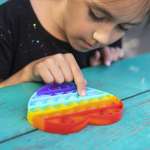Self-Regulation Techniques for Kids with ADHD

Children struggle to control and understand their emotions. However, children with attention deficit hyperactivity disorder (ADHD) their ability have brains that work differently and making their responses often seem more intense or out of control.
However, despite an ADHD diagnosis, through the help of calming techniques, sensory toys, medication, and therapy, many children with ADHD learn the necessary self-regulation skills needed to prevent most meltdowns and allow a child to focus their attention on necessary tasks
Related: The Best Fidget Toys for Kids with ADHD
How Does ADHD Affect Self and Emotional Regulation?
ADHD and ADD impair executive function, which children naturally lack developmentally, making managing time, attention, and emotions challenging. This lack of control makes a child with ADHD’s outbursts seem even more intense than a sibling's or classmate's.

Many children with ADHD are extremely intelligent, but their social-emotional skills are often behind in development, making a child appear younger or immature.
Children and Adolescents with ADHD Often:
- Lack the ability to read or pick up on social cues
- Become easily distracted during conversations appearing rude or as if they’re not listening.
- Have difficulty following through on commitments
- Overreact to situations due to emotional dysregulation
Can Children with ADHD Self-Regulate?
Children and teens with ADHD can self-regulate. Of course, not all the time, and not without practice and the proper tools, but most children, when they receive proper ADHD treatment, can engage in calming strategies that increase their executive functioning skills and fully participate in everyday life.
25 Best Fidget Toys for Kids with ADHD
Attention deficit hyperactive disorder (ADHD) is one of the most common medical conditions affecting American children. Kids with ADHD often have difficulty focusing, keeping still, and practicing self-regulation. Read More
If you’re wondering, “Does my child have ADHD?” or “What can I do to help with my child’s self-regulation?” the first step is to contact the child’s pediatric office. Talking with your child’s doctor about the symptoms you observe, the frequency, and any triggers (bedtime, transitions, after school, etc.) will help the physician create a list of possible calming techniques or strategies to try.

Despite all the calming activities and gadgets in the world, some children require medication. There is nothing shameful about a child needing ADHD medication, and many safe options are on the market for children and teens. For my son, it is night and day, and taking daily ADHD medication paired with practicing other coping skills allows him to focus and remain productive at school.
With medication, therapy, and coping mechanisms, it may take a few tries and several months to find what works best, so don’t give up hope if, at first, it doesn’t seem like there’s much of a difference.
Activities to Help Children with ADHD Self-Regulate?
Because mental health has taken center stage in the last decade, and rightfully so, there are so many more resources available for parents of children with ADHD and other neurodivergent conditions like autism, sensory processing disorders, and oppositional defiant disorder.
Of course, there is no full-proof method to avoid tantrums and outbursts. Even we as adults lose control of our emotions from time to time. But, putting the time in to develop self-regulation strategies that work for your child will help them develop emotional control.
Read a Book Together or Tell Stories

Books and stories are among the best methods of teaching children anything. Books allow children to escape into the characters and discuss big feelings they may have without directly expressing the feelings themselves. A child having a hard time processing a big emotion may see themselves in a character and relate.
Children may also enjoy making up stories or acting things out with puppets or stuffed animals. For example, my son with ADHD often tells me stories about what his stuffed animals have experienced that day to express his big feelings in a way that feels safe to him.
Some excellent books to help children with ADHD are:
- My Whirling, Twirling Motor by Merriam Sarcia Saunders & Tammie Lyon
- Ninja Life Hacks: Self Management Set by Mary Nihn
- My Body Bubble by Michael Gordon
- Fiona Flamingo by Rachael Urrutia
- I Was So Mad: Little Critter & I Just Forgot: Little Critter by Mercer Meyer
- My Busy, Busy Brain: The ABCDs of ADHD by Nicole Russell
Take Movement Breaks and Exercise

Children, adults, and teens with ADHD need movement to help refocus their brains. So if your child is attempting to work on homework or a school project, allow them to get up and move around after ten or fifteen minutes. There are tons of movement break ideas online! A little movement break video is an active and playful way to engage with technology instead of passively.
Get off the couch together with these 8 Family Fitness Activities you can do right now!
Use Sensory Toys and Fidget Toys

Sensory fidgets or toys are an excellent tool to help with children’s self-regulation. Sensory fidgets come in various shapes, colors, and textures and are often items your child can squeeze, stretch, twist, or even chew on if needed.
Sensory fidgets provide an outlet for the brain and body’s need for movement and help children who struggle with inattention remain focused in class or on their work.
Try Meditation, Deep Breathing, and Yoga

Meditation, breathing exercises, and yoga have immense benefits for all children. For example, teaching a child to use deep breathing when upset effectively calms their nerves and diffuses anger or other strong emotions.
Cosmic Kids is a superb children’s yoga series that uses familiar stories to help children go through a series of calming and stretching yoga poses.
Even if you don’t have the time to engage in an entire yoga session, the simple act of having your child invert their head provides a calming effect.
For more ways to practice mindfulness with kids, see our list of 3 Family Mindfulness Activities you can practice at home!
Limit Electronic Use and Screentime for Kids

In our electronic and digital age, it has become challenging for parents to reduce electronic use and set screen time limits as much as possible. And we get it; sometimes the iPad or a round of video games is the only thing providing you 15 minutes of peace and quiet. However, try to limit a child with ADHD’s electronic use when and as much as possible.
Offer to play board games and cards, play outside, paint, draw, cook together, build LEGOs, or any activity that engages their minds, bodies, and hands. Children with ADHD often struggle to read themselves but enjoy being read to or listening to audio stories where they can imagine the scenes themselves.
Additionally, try to limit the amount of time engaged in passive electronic use, like watching television. There are many educational websites and games that require your child to think and engage while using electronics.
Check out our list of The Best Learning Websites for Pre-Schoolers and Kindergarteners.
Ways Adults Can Help a Child with ADHD Self-Regulate

Caregivers, teachers, and parents who lack an understanding of what ADHD is and how it works often label children with ADHD as “bad” or lacking self-control. These negative thoughts and lack of understanding often result in punishment for behavior a child cannot yet control.
Punishment for ADHD-related behaviors causes a child to develop low-self esteem and thoughts that they are stupid or bad, resulting in further acting out, lower grades, and additional behavioral problems.
Therefore, the first thing you can do if your child or a child you know has ADHD is to self-educate. The better you understand ADHD and how it makes your child’s brain tick, the more patience you will have, and the better you can educate others.
A better understanding of how ADHD impairs a child’s self-regulation skills gives you the knowledge and ability to react more calmly and productively.
Additionally, stay calm when your child upsets you or is struggling to follow directions. If you, as an adult, can better control your own behavior and emotional response to your child, you will set the example for calm problem-solving and self-monitoring.

However, it is essential to mention that remaining calm and understanding of your ADHD child’s limitations does not mean accepting inappropriate behavior. Children with ADHD can and should still be disciplined when they are out of line or failing to meet realistic and developmentally appropriate expectations, but remember, discipline means “to teach,” not punish.
Children with learning disabilities of any type must be met at their developmental level, not necessarily their biological age level. Therefore, when mistakes or inappropriate behavior occur, adults must take the time to explain why their behavior was unacceptable and help their children develop self-awareness and appropriate social skills.
Over time with patience, understanding, and probably more than a few re-starts, your child with ADHD will develop a working memory of what works and feels right to them and be in better control of their attention, emotions, and reactions.


